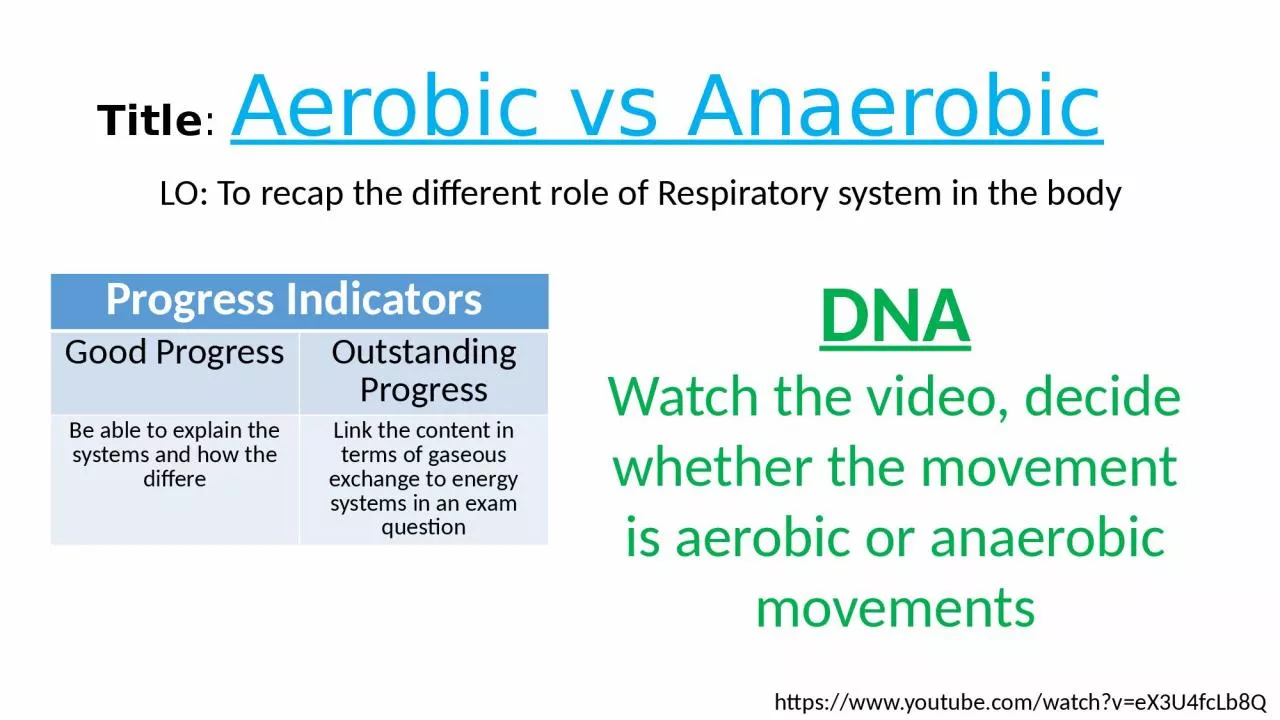

LO To recap the different role of Respiratory system in the body Progress Indicators Good Progress Outstanding Progress Be able to explain the systems and how the differe Link the content in terms of gaseous exchange to energy systems in an exam question ID: 1033407
Download Presentation The PPT/PDF document "Title : Aerobic vs Anaerobic" is the property of its rightful owner. Permission is granted to download and print the materials on this web site for personal, non-commercial use only, and to display it on your personal computer provided you do not modify the materials and that you retain all copyright notices contained in the materials. By downloading content from our website, you accept the terms of this agreement.
1. Title: Aerobic vs AnaerobicLO: To recap the different role of Respiratory system in the bodyProgress Indicators Good ProgressOutstanding ProgressBe able to explain the systems and how the differeLink the content in terms of gaseous exchange to energy systems in an exam questionhttps://www.youtube.com/watch?v=eX3U4fcLb8QDNAWatch the video, decide whether the movement is aerobic or anaerobic movements
2. Aerobic exerciseAerobic exercise need a sufficient supply of oxygen to the tissues.Work for a long timeModerate – hard work Periods of more then 60sGlucose + OxygenCO2 + water + Energy Anaerobic exerciseNo oxygen is used in its initial release, energy is produced from the supplies already in the body. Maximum bursts of energy Time it takes to do is very short Glucose Energy + Lactic acid Extension task Explain how a games player would use both aerobic and anaerobic systems (4 marks)
3. Aerobic exerciseAerobic exercise need a sufficient supply of oxygen to the tissues.Work for a long timeModerate – hard work Periods of more then 60sGlucose + OxygenCO2 + water + Energy Anaerobic exerciseNo oxygen is used in its initial release, energy is produced from the supplies already in the body. Maximum bursts of energy Time it takes to do is very short Glucose Energy + Lactic acid Extension task Explain how a games player would use both aerobic and anaerobic systems (4 marks)
4. Energy Glucose + oxygen -----Energy + CO2 + water Glucose -----Energy + lactic acidAerobic Respiration -The muscles and liver store glucose (main source of energy from food) Anaerobic Respiration -Is toxic!, causes muscle ache, cramps eventually stopping them from working! Fats:Fuel source for aerobic activity The muscles and liver store glucose (main source of energy from food) Carbohydrates:Fuel source for anaerobic and aerobic activity
5. Oxygen debt Oxygen debt is….Oxygen debt is…The amount of oxygen needed at the end of a physical activity to break down lactic acid. Often after a 400m race lactic acid builds up as the oxygen stores have run out. Oxygen is repaid through deep gasping breaths at the end of exercise.Glucose -----Energy + lactic acidAnaerobic Respiration -
6. Explain how the Cardiovascular system and the respiratory system work together (6)?Apply knowledge and understandingknowledge and understanding of a topicAnalyse and evaluate StatedefinedescribeIdentify Explain howExplain whyGive examples to back up your pointassessdiscussJustify whyevaluateanalyse
7. RespiratoryIncreased breathing rate Oxygen debt (take on enough oxygen until it is paid off)Increased tidal volumeMuscularLactic acid build up (during anaerobic exercise) – known as lactate accumulationMuscle fatigue (because of the build up of lactic acid)Oxygen debt as a result of anaerobic exerciseCardiovascularIncrease heart rateIncrease in stroke volumeIncrease cardiac outputIncrease in blood pressure (diastolic & systolic)
8. Long term effects Increased lung capacity / volumeIncreased vital capacity Diaphragm and intercostal muscles get strongerNumber of alveoli increasesIncrease strength Increase size (hypertrophy)Increase bone density Increased strength of ligaments Increase strength of tendonsMore capillaries in the musclesIncreased cardiac outputIncreased Stroke volumeDecreased resting HRFaster recovery Healthy Veins and arteriesLower blood pressure More red blood cells Muscular-Skeletal RespiratoryCardiovascularAll means you have a quicker recovery rate
9. Task Functions of the cardiovascular systemMuscle fibresStructures of arteries, capillaries and veinsGive a sporting example of the anaerobic system & aerobic system working together (explain how)Make any form of revision tool in your homework book on the content on the left (all 4 bullet points)“If you do what you’ve always done…you get what you’ve always got!”